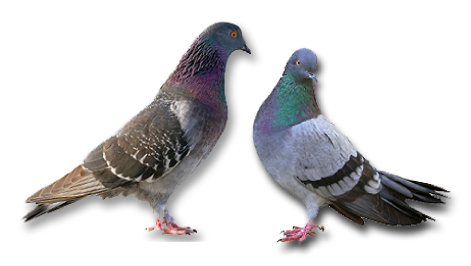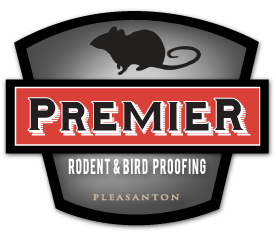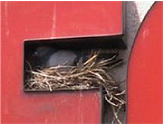Most of the pigeons you see around a city, building, bridge, billboard or other structure,
are pigeons that were born and raised close by. A few may be "vagrants" and constantly
on the move, but most of them are going to be your neighborhood pigeons that will be
nesting and breeding near to where you see them if food and water is close by. Feral
pigeons (Columbia livia) are the number one urban pest bird, causing damage where
ever they nest or roost. Pigeons are descendants of domesticated European homing
pigeons or Rock Doves, so they have a varied diet and feel at ease making their homes
in man-made structures. Generally blue-grey in color, with iridescent feathers on the
head and neck, pigeons often have markings in black, white or brown on the wings and
neck. A short neck and small head characterize the standard pigeon; their short legs,
hind toes and level front allow for both easy perching on pipes and ledges or walking on
flat surfaces. Pigeons generally nest in small, flat areas away from the ground such as
building ledges, air conditioning units or window sills.
Pigeons will inhabit any area that will offer them shelter from the climate, for example:
ornate architectural features of buildings, lofts, church steeples, attics, and any place
with openings that allow for roosting, loafing, and nesting. Pigeon nests consist of twigs,
sticks, and grass clumped together to form a platform. Pigeons are monogamous birds.
"Eight to twelve days after mating, the female will lay 1 or 2 eggs which hatch after
approximately 18 days. The male, during this time, is providing nesting material and
guards the female and the nest." When pigeons are born, they feed on pigeon milk
which is "a liquid/solid substance secreted in the crop of both adults that is regurgitated"
into the mouths of the young pigeons. Most young leave the nest at approximately 4 to
6 weeks of age. During this time another batch of eggs may have already been laid.
Breeding most commonly occurs during the spring and fall, but reproduction can occur
all year long. A flock of pigeons will normally have an equal amount of males and females.
A pigeon's normal lifespan in nature is about 3 to 4 years. A pigeon can go, if necessary,
a long time without food or even water. Most birds need a constant water source and
that they will visit every day. Pigeons are skilled in finding water and food sources, and
rarely have trouble finding a source in the city. Individual pigeons can have a home range
of 150 miles, although most will stay close to home, which is generally considerably less
than 25 miles or so. If their food and water sources change drastically, however, they will
migrate, to another spot, near or far, with better provisions.

Pigeon control is important due to the damage and disease problems these birds
often create, check out Health Risk page. The uric acid in pigeon feces is highly
corrosive and can cause extensive damage to metals and other substrates it sits on
for long periods. Debris from flocks of problem pigeons often build up, backing up
gutters and drains which can cause flooding and roof damage. Nesting materials
and other debris has caused failures in machinery, especially rooftop air conditioning
units which are a prime nesting spot for pigeons. Other frequent pigeon problems
include slip and fall liability from feces or debris, plus an unclean, dirty company
image is presented when pigeons are roosting all over a building or store front sign.
The bacteria, fungal agents and ectoparasites found in pigeon droppings are responsible
for a host of serious diseases, including histoplasmosis, encephalitis, salmonella,
meningitis, toxoplasmosis and more. Pigeons also carry ectoparasites for example:
fleas, lice, mites, ticks, and other biting pests. Many companies have significant clean
up costs due to the pigeon problems that they don't resolve. The pigeons that are
located around airports threaten human safety due to a possible bird-aircraft collision.
The U.S. Air Force considers pigeons as a medium priority hazard to jet aircrafts.

Remember to respect the pigeon. This chubby little bird has the uncanny ability to
find it's way home, no matter what, and no matter from where. To date, science can
only theorize as to exactly how the pigeons do this.
Trying to discover or prevent pigeons from returning home, researchers have tried to
confuse them in every way possible. By transporting them to a remote location: In the
dark, in randomly rotating cages, with strong or weak magnetic fields, with flashing
lights, and even anesthetized, or any combinations of these, (and others too) nothing
seemed to affect their navigation skills, even in unfamiliar territories.
Pigeons are suspected of using magnetic structures already known to be in their
brains, but there was still no change in their ability, even when tiny, removable
magnets were attached to their heads, supposedly to confuse these structures.








